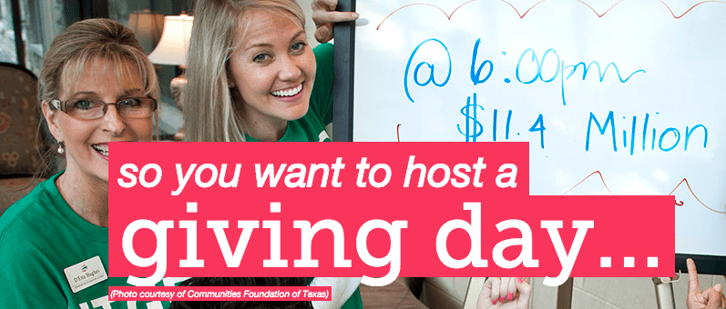Is your foundation or nonprofit thinking of hosting a Giving Day or crowdfunding campaign? At Rad Campaign we've helped launch several crowdfunding campaigns, raised a lot of money along the way, and learned how much hard work it takes to pull these campaigns off successfully.
Why launch a Giving Day? According to the Giving Day playbook, Giving Days have:
- Strengthened the capacity of community foundations to fundraise and engage a broader set of donors online.
- Helped establish credibility with nonprofit and donor participants.
- Increased community foundations’ online fundraising presence.
- Helped increase philanthropy and brought in more philanthropists as a result of the campaigns.
- Demonstrated the value of low-dollar donations.
- Positioned community foundations (and nonprofits) as hubs of information in their communities.

While Giving Days and crowdfunding campaigns have the potential to raise a lot of money online, it's important that you prep for them at least 6 to 8 months in advance.
Here's a high-level checklist to get you started on your Giving Day:
- Identify your staff capacity for implementing a Giving Day. While you will need a designated point person from your fundraising team to do a lot of the work, it's best to treat this as an inclusive campaign that leverages your staff from communications, programs, social media, public policy/advocacy, etc.
- Develop a realistic fundraising goal for the Giving Day or the campaign.
- Define your target audience, and get specific.
- Choose a donation platform. There are several vendors to choose from such as Crowdrise, Razoo, Classy, Kimbia, etc. You can check out this evaluation tool to analyze and compare several platforms by looking at corporate stability, features and benefits, hosting architecture, capacity, pricing, and policies.
- Create a Giving Day high-level timeline/calendar/workplan as well as a detailed version that breaks down every step. This will also give you an opportunity delegate assignments to specific staff people with plenty of advance notice.
- Create a communications plan (email, social media, and any print, radio, or TV ads/PSAs, and even op-eds) for your Giving Day.
- Develop a 72-hour workplan, timeline/calendar. You should do this for 2 days leading up to the Giving Day, and 24 hours following the Giving Day for reporting, sending out thank you emails, etc.
- Create a Giving Day budget. This should include any consultants you plan to hire, paid ads, fees to crowdfunding platforms, etc.
- Determine if you will offer prizes and match incentive options.
- Identify partners for prizes and matching funders. These partners and funders can range from philanthropists to corporate partners.
- Define what metrics you will track and what your ROI will look like.
- And last but certainly not least, develop a crisis communications plan. You can have the best workplan and communications plans in place and ready to go, but if a crisis arises (like a glitch with the crowdfunding platform), you must prepare for this well in advance.
"Running an online campaign that relies on a single platform for a short period of time involves some inherent risk. Giving Day organizers should expect and plan ahead for technology glitches—possibly even major failures. In the case of a full website shutdown, some Giving Day organizers extended the length of their campaigns, accepted donations over the phone, and encouraged donors to give directly to nonprofits outside of the Giving Day websites," states the Giving Day Playbook.
Beth Kanter recommends using “Table Top Crisis Planning,” an interactive exercise that allows you to look at the first 72 hours of a response to a disaster and brainstorm innovative ways to address it before it happens.
Kanter said that GiveMN, which was one of the earliest and largest Giving Days, learned the importance of having a crisis plan during a catastrophic technical glitch in 2013. “We have all our messaging ready to go for any emergency so we don’t have to create messaging from scratch. We just have to revise it and get it out,” says Tom Zimmerman, the group’s marketing and communications manager.
For example, "GivenMn has taken an idea from Google’s playbook and created a status page that identifies 15 different site features and states whether they are working. They have trained their front line staff to refer nonprofits and donors to the page and go through a series of diagnostics to determine if the technical problem is system-wide or for just one user," said Kanter.
What other tips do you have for creating a successful Giving Day or crowdfunding campaign?



COMMENTS